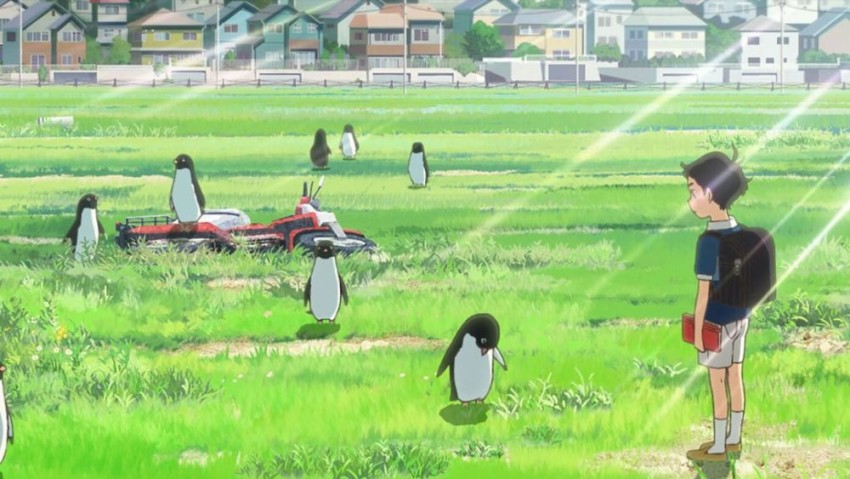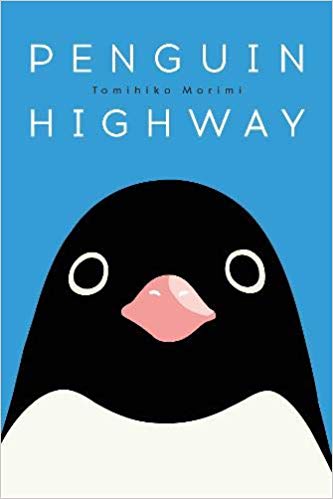Books: Penguin Highway
April 30, 2019 · 0 comments
By Jonathan Clements.
 “When I was in third grade, I spent September and October researching square things.” It is a typical statement from Aoyama, the super-serious pre-teen narrator of Tomihiko Morimi’s Penguin Highway. It is a comment of simple truth, but hints at statistical obsessions, an eidetic memory, and an inadvertent hint of recursive SF, recalling the inter-dimensional classic Flatland.
“When I was in third grade, I spent September and October researching square things.” It is a typical statement from Aoyama, the super-serious pre-teen narrator of Tomihiko Morimi’s Penguin Highway. It is a comment of simple truth, but hints at statistical obsessions, an eidetic memory, and an inadvertent hint of recursive SF, recalling the inter-dimensional classic Flatland.
Aoyama is an intensely inquisitive boy, determined to investigate all sorts of mysteries, unaware that his latest obsession is truly earth-shattering. Because he isn’t spending this summer thinking about square things, or boobs (life’s greatest mystery, he posits), or chess games, or Cambrian fossils. He is trying to work out why his anonymous suburban hometown is over-run with penguins.
 It’s hard to miss the English-language publication of Penguin Highway – it’s been all over the advertising banners on Anime News Network like a rash, showing off the iconic cover image derived from Hiroyasu Ishida’s acclaimed anime adaptation. The publication of Andrew Cunningham’s translation of the original novel serves to demonstrate just how good and close an adaptation Ishida’s anime was. The anime sold itself, as does this book, on the cute look of its swarm of penguins, although like so much else in the story, they are really red herrings – outer manifestations of a far more complex phenomenon. Things are most definitely not as they seem, which is why an unreliable narrator is such a wonderful coup in Morimi’s gentle, hopeful novel.
It’s hard to miss the English-language publication of Penguin Highway – it’s been all over the advertising banners on Anime News Network like a rash, showing off the iconic cover image derived from Hiroyasu Ishida’s acclaimed anime adaptation. The publication of Andrew Cunningham’s translation of the original novel serves to demonstrate just how good and close an adaptation Ishida’s anime was. The anime sold itself, as does this book, on the cute look of its swarm of penguins, although like so much else in the story, they are really red herrings – outer manifestations of a far more complex phenomenon. Things are most definitely not as they seem, which is why an unreliable narrator is such a wonderful coup in Morimi’s gentle, hopeful novel.
Aoyama’s over-assured narration is sustained for the whole book, a focussed, statistically minded series of factual statements – some true, some plainly not. But he is 100% sure about all of them, as if the autistic-spectrum lead of The Curious Incident of the Dog in the Night-Time suddenly had to contend with an influx of penguins. The similarities, in fact, with Mark Haddon’s best-seller, which was translated into Japanese by the SF publisher Hayakawa Shobo in 2003, are so close that one could almost believe Penguin Highway to be an exercise in Curious Incident fan fiction – although Morimi denies having read the book.
Like Haddon’s hero Christopher, Aoyama manages to be charmingly self-involved – a difficult trick for a narrator to pull off. But as the Lady in the Dentist’s Office observes, he’s still only a kid, so he gets a bit of wiggle room on what, for an older character, might be regarded as narcissistic behaviour. Aoyama is not quite as smart as he thinks he is, and there is a delight of discovery in the things on which he fixes his quirky attention. He sees, for example, that the children’s fathers do not get home until after dark, enduring long commutes away from the homes they supposedly love, and off-handedly observes how consumerism has turned the boxy shopping mall in town into an amusement park for late capitalism. Aoyama’s musings demonstrate how even our solid reality is frangible and plastic – the plan to build a railway station in his town, he observes, will effectively bring the seaside closer.
There is an equal joy to be found at the things that Aoyama leaves out. “On the last day of school,” he writes, “we all went to the gym, listened to a speech from the principal, and then helped clean everything.” Aoyama makes no attempt to pay attention to what the principal actually said, since it is utterly immaterial to him. He has so much to think about, including time, black holes, and magnets.
Aoyama’s self-confidence allows the author to throw in some distracting feints – right from the start, his claim that the town he lives in did not exist before his arrival is enough to prompt the suspicion that Aoyama is himself a product of a pocket universe, and that perhaps not merely the penguins, but the town itself is an artificial construct. There are several more clues along such lines, scattered throughout the novel, but ultimately proving to be a false trail.
Scattered with references to Lewis Carroll, Penguin Highway is a novel of first contact, in which neither side is equipped to communicate with the other. In Aoyama’s interactions with the Lady at the Dentist’s Office we are being asked to watch two alien intelligences interact. Aoyama is a unique intellect, but so is the Lady, and neither of them has a particularly everyday, neurotypical perspective on life in Aoyama’s town.
Whereas the similar-plotted Arrival (based on Ted Chiang’s Story of Your Life) dealt with the successful establishment of communication, Penguin Highway artfully and realistically depicts humanity floundering in the earliest stages, like kids trying to make sense of the universe. The reader is lulled into sense of false superiority, snickering indulgently at Aoyama’s blinkered worldview, until it becomes plain that in the case of a technology so advanced that it is indistinguishable from magic-realism, we would all be clueless children.
The book also includes an afterword by manga creator Moto Hagio, which depending on your perspective, is either a sophomoric summary of what you’ve just read, or a prolonged pastiche of Aoyama’s narrative style, stating the facts all over again in an odd enough way to create a sense of curiosity. Hagio points to the deep and ultimately platonic romance at the heart of the book, that Aoyama’s love of learning has turned the Lady into a Muse, propelling him onto great things and a bright future.
“When I read the last page of this boy’s story,” she writes, “I wanted to hug Aoyama and this book.”
Jonathan Clements is the author of A Brief History of Modern Japan. Penguin Highway, translated by Andrew Cunningham, is out now from Yen Press, while the film is released by Anime Limited.
Leave a Reply